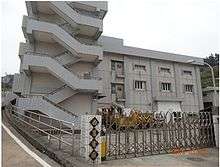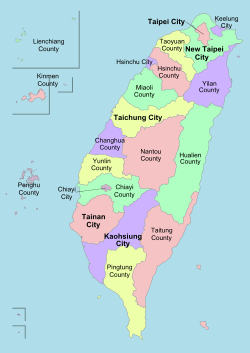Juguang, Lienchiang
Coordinates: 25°57′50.5″N 119°57′32.9″E / 25.964028°N 119.959139°E
| Juguang Township 莒光鄉 | |
|---|---|
| Rural township | |
|
Juguang Township in Lienchiang County | |
| Location | Lienchiang, Taiwan |
| Area | |
| • Total | 4.7 km2 (1.8 sq mi) |
| Population (July 2018) | |
| • Total | 1,643 |
| • Density | 350/km2 (910/sq mi) |
Juguang Township (Chinese: 莒光鄉; pinyin: Jǔguāng Xiāng; Wade–Giles: Chü³-kuang²; Foochow Romanized: Gṳ̄-guŏng-hiŏng), also spelled Chukuang, is a rural township of Lienchiang County, Republic of China. Juguang Township includes two major Matsu islands -- Dongju Island (東莒 "East Ju"; Dĕ̤ng-gṳ̄) and Xiju Island (西莒 "West Ju"; Să̤-gṳ̄) -- and some islets. Neither Dongju nor Xiju has an island-wide administrative level.[1]
History
Dongju and Xiju Islands were previously named Dongquan (東犬; Dĕ̤ng-kēng) and Xiquan (西犬; Să̤-kēng) Islands, meaning "Eastern Dog" and "Western Dog" respectively. They have also been called the Baiquan Islands (白犬島; Băh-kēng-dō̤) or Baiken Islands (白肯島).
They were renamed from a quote of a speech by Chiang Kai-shek, "forget not that you're in Ju" (毋忘在莒; Ù uông câi Gṳ̄). It refers to the City of Ju, where the king of Qi prepared a counterattack that retook his country from the State of Yan. This is an analogy of Matsu and Taiwan as bases of the Republic of China (ROC) to regenerate itself and one day recover mainland China from the Chinese communist. This renaming, of course, is not recognized by PRC, which keep their original names.
The islands were originally part of the Changle County before the ROC government evacuated to Taiwan. It is considered by the People's Republic of China government as part of Changle City of the Fuzhou City.
Geography
Dongju, the southernmost of the Matsu Islands, is 2.63 km² and Sijyu 2.36 km². Islets includes like Yongliu (永留嶼 Yongliu) near Dongju. Dongju is shaped like a dagger, while Xiju a triangle, so seemingly bigger on maps. Some cliffs of Dongjyu is severely corroded by wind, creating a strangely aesthetic appearance.
Administrative divisions
Administratively the islands are part of the Lienchiang County. Both islands have villages as the first-level division within:
- Xiju Island
- Qingfan Village (青帆村 Qīngfán)
- Xiqiu Village (西坵村 Xīqīu)
- Tianwo Village (田沃村 Tiánwò)
- Dongju Island
- Daping Village (大坪村 Dàpíng)
- Fuzheng Village (福正村 Fúzhèng)
Infrastructure
Electricity supply

The township is powered up by Xiju Power Plant located in Xiju Island.
Water supply
Previously, water supply had been scarce in Xiju Island despite having water wells drilled around the island by the residents. Later the military built a dam and formed the Ledaoao Reservoir for the water needs of residents, defense and irrigation.[2]
Tourism
The 19.5-metre (54-step) Dongquan Lighthouse on northern Dongjyu, made during the late Qing Dynasty with granite. The guiding light is in the shape of a clam and can reach 16.7 nautical miles (30.9 km). Dongju Lighthouse is a second-level national historic building. In front of the lighthouse, there used to be four mist-cannon for signaling, but has now been removed and placed in the Cultural Museum of Matsu History (馬祖歷史文物館 Matsu Lishi Wenwuguan).
The 42-character Dapu Stone Inscription (大埔石刻), in Dapu Seaport of Dongju, was made during the Wanli era of the Ming Dynasty, concerning the capture of pirates alive. Remembering-the-Past Pavilion (懷古亭 Huaigu Ting) was constructed in 1966 sheltering the stone.
In the sea south of the Sijyu, there is Snake Mountain (蛇山). The main island has a small Green-sail Seaport (青帆港), two water reservoirs and a middle-elementary school, but are not major tourist attractions.[3]
Transportation
There is one accessible seaport on Xiju, and two on Dongju. Juguang can be reached by ferry from Fuao Harbor in Nangan or by helicopter which only operates during the winter and priority on which is given to local residents.
Notable natives
- Chen Hsueh-sheng, Magistrate of Lienchiang County (2001-2009)
See also
References
- ↑ "Juguang - Matsu National Scenic Area". Matsu-nsa.gov.tw. 2012-08-13. Retrieved 2014-04-23.
- ↑ "Ledaoao". Matsu National Scenic Area. Retrieved 12 May 2017.
- ↑ http://www.matsu.gov.tw/en/page/Location4.php
| Wikimedia Commons has media related to Juguang, Lienchiang. |
